How to Escape Egypt’s Crowds on a Chic Nile Sailboat
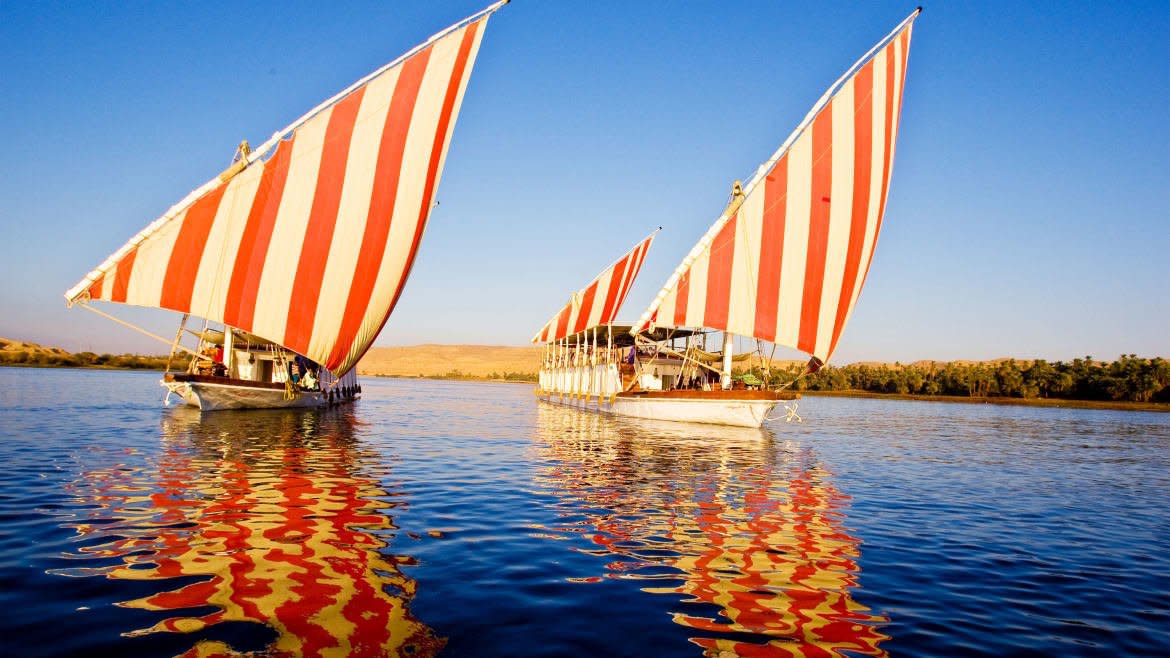
I have a paralyzing fear of sharks, a fear that has always prevented me from water skiing because while I wait for the boat to accelerate all I can think about is how my butt—sticking into the water as I try to keep my skis up—probably looks especially snackable.
So it’s no surprise that on a trip this past week to Egypt, while floating in the cool midnight-blue waters of the Nile, it was impossible for me not to think about crocodiles and just relax .
Sure, there were plenty of people around, all of us enjoying a respite from temperatures that had reached 112 degrees one day. I saw hundreds of kids playing in the river, and news articles state that the reptiles are extinct here. But what if one croc had gotten over the dams, and, out of all the legs flicking about under the swift current, mine were the ones it latched on to?
And yet I couldn’t help myself. Crocodiles or no, I went in the water over and over and over. After all, I was swimming in the Nile, a river that loomed so large in my ancient history-obsessed brain that I couldn’t believe I was finally on it. I was on a chic dahabiya, a traditional Egyptian sailboat operated by the boutique cruise Nour el Nil. On board, the Nile turned out to be everything I’d hoped it would be and more. And on the boat, I managed to do that which can seem impossible in Egypt—I escaped the crowds.
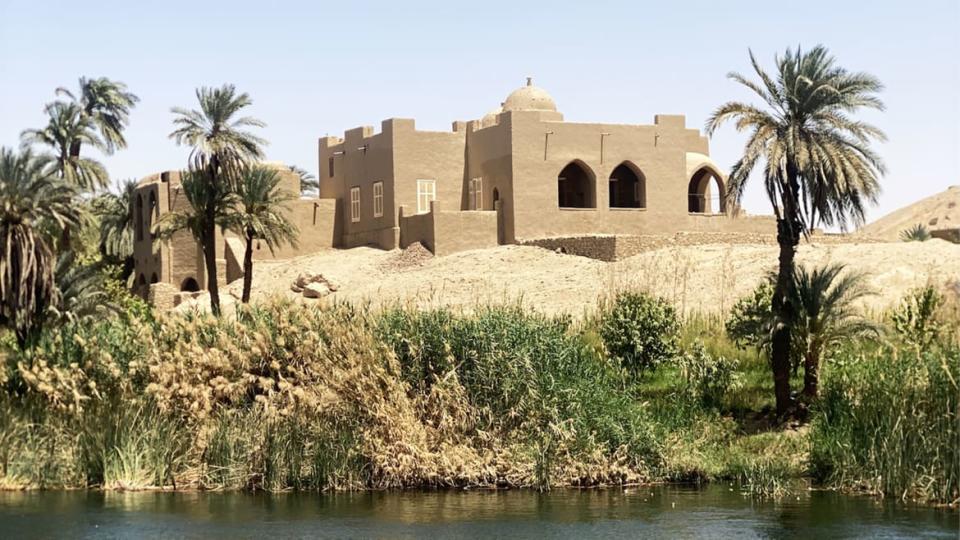
The riverside home of the archaeologist who explored El Kab.
My trip began in Cairo, which is everything you’d imagine one of the world’s most densely populated city to be: highways that are officially four lanes but drivers operating like there are seven; countless pedestrians weaving through the speeding cars; and endless crumbling and dusty cement apartment blocks packed cheek to jowl. Teeming doesn’t seem up to the task of describing this place.
You exit the Cairo airport to the predictable gauntlet of drivers looking for a fare, but it’s pretty easy to use Uber or have a driver arranged in advance through a fixer. If you’re not doing the trip through an official tour operator—which, to me, seemed overpriced—a fixer is recommended for arranging everything in this often overwhelming country where everybody is friendly but you can quickly be drained if you look for a second like you aren’t sure where you’re going or what you need. I went with a fixer my friend used, but my main recommendation, if you want to learn from my mistakes, is to know in advance exactly what you want to do and see. Otherwise you’ll be on a kind of conveyor belt of the greatest hits that every tourist pretty much gets. (They’re still epic hits, to be sure.) That goes, too, for the food, so if that’s important to you, do your own research or work on it closely with your fixer.
My first couple nights were in Giza, which is just on the western bank of the Nile while Cairo is on the eastern side. On the way, you drive past the sprawling City of the Dead (on my list for my next visit). Then, on a clear day, the pyramids appear in the distance. Trite, yes, but they’re huge.
Unwilling to splurge on Mena House while it’s being renovated—and mistakenly avoiding all the “Pyramid View” small hotels right opposite the Sphinx—I opted for the Steigenberger. It had a view of the pyramids and it looked very much like a Y2K-era Marriott that you stayed in as a kid on sports tournaments: a bit tired with bad WiFi but clean, convenient, and with a big pool. It’s also right next to the humongous Grand Egyptian Museum, which is supposed to open this fall, although it feels like every six months the government says it will open in six months. If I did it over, on a budget, I’d stay in one of the basic “Pyramid View” hotels; or if you want to splurge, do Mena.
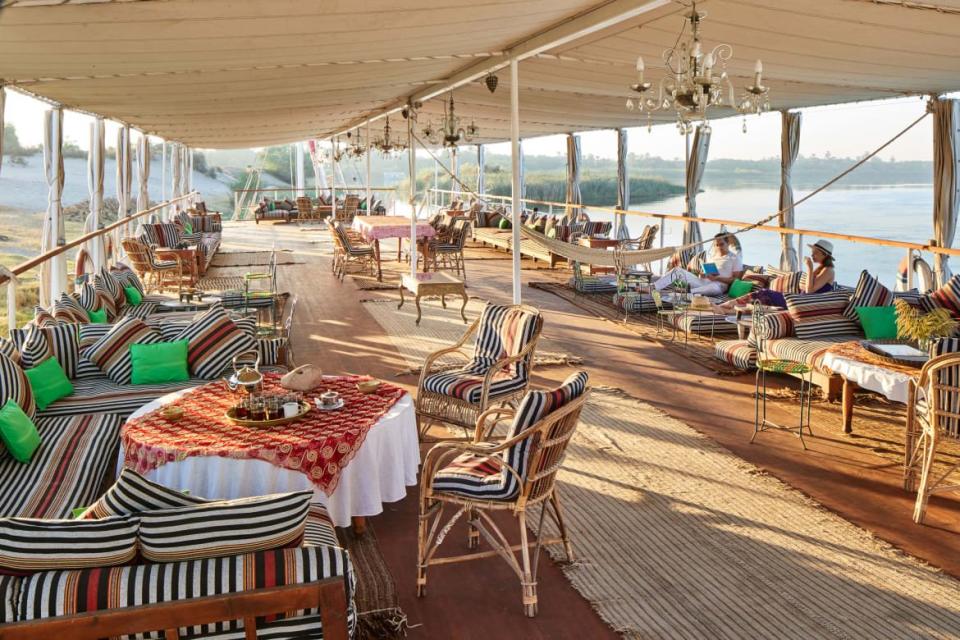
The lounge deck of the Meroe.
For some reason, I had this idea in my head that the Sphinx was going to underwhelm; instead, I found it absolutely mesmerizing, despite the crowds. The conveyor-belt tour will also take you to the Egyptian Museum in central Cairo. I found it as crowded as the Met on a Saturday but given tourism is still at a historic low, I can’t even imagine how impossible it is during normal tourism times. Still, you can add the content of King Tut’s tomb to the rapidly growing list of things here that surpass your expectations.
You’ll also visit the Citadel, which has the 19th-century alabaster mosque built by Muhammad Ali. Many of the palaces and houses you can easily tour are from the royal family that ruled in the 19th and first half of 20th century. And while their lucre is astounding, I would’ve found exploring the remnants of the Fatimid, Ayyubid, and Mamluk periods more edifying. Next time!
One note about hotels in Cairo, and Egypt in general. I struggled to find really cool or creative boutique hotels in Cairo, and there only appear to be a couple in the country in general. You have a lot of big chain hotels (in Cairo, the Kempinski was the best we experienced) and hostel-type situations. But if you’re hoping to find something akin to a riad in Morocco, that just isn’t here in Cairo as of now. The country as a whole only has a handful, such as the Al Moudira in Luxor and the just-opened Ben Ben by Dhara Hotels in Aswan. For historic sites, your main options are the Winter Palace in Luxor (kind of tired) and the stunning Old Cataract Hotel in Aswan, both run by Sofitel.
From Cairo I flew to Luxor, home of the largest temples as well as Valley of the Kings and Valley of the Queens. My guide there, Shaimaa, was one of the best I’ve ever had so I am hyperlinking to her email here. I’ve long found ancient Egyptian history a bit slippery when trying to piece it all together, and she’s the first who left me with a decent grasp. While Vegas had polluted the name Luxor in my mind, the temples here are so magnificent and grand I’m still processing them. One piece of advice when you do the Valley of the Kings or Queens is to go at the crack of dawn because as tourist numbers go up, the lines snake out of each tomb into unprotected desert, which will sap you.
All of this about crowded sights, conveyor-belt tourism, and chain hotels isn’t to knock on Egypt—tourism comes in all sorts of experiences and you should enjoy places for what they are. But it made finding Nour el Nil feel particularly special. Riding aboard Nour el Nil is rented elegance. For five nights you lounge about on cushioned banquettes on a deck as palm trees and reed-covered banks float past, with the dunes of the Sahara and villages popping up now and then. Sometimes, you’ll even look up from your book and tombs raided centuries ago will pass by a dozen yards away.
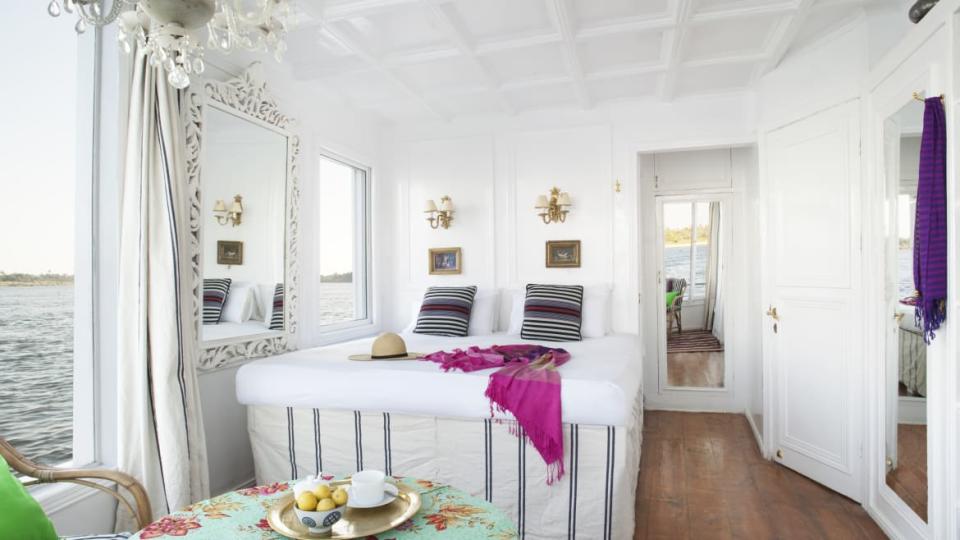
A Panoramic Cabin
The company operates six dahabiyas, flat-bottomed wooden sailboats painted white with candy cane-striped sails fore and aft. The top is a giant lounge and dining area covered by a canvas tent and below it are the cabins and a lacquered white library with striped couches and upholstery. The boats range in size and age, which is reflected in the prices which range from 1,250 to 2,250 euros per person for the regular cabins and 1,900 to 3,400 euros for the panoramic cabins at the back which have floor to ceiling river views. The website and sales staff can seem frustratingly vague as you try to sort the difference between cabins and boats. They tell you the only differences are in terms of age and size of the boat overall, and that’s actually the truth. (In terms of size, this mainly means that the newer bigger boats have more lounging space on top.) So if you don’t need the brand new room and bathroom and you’re budget conscious, you’re just as well looking at one of the regular cabins on one of the older boats. I stayed in one on the Meroe which was refurbished in 2017, and while the room is perfectly lovely, I spent nearly all my time on top lounging and watching the Nile go by.
The boats set sail on a Monday, which is a day or two after all the big cruise ships. The cruise ships also all arrive at the same time to each sight, crowding column halls and filling tombs. The dahabiyas not only leave later, but also go at a slower pace, meaning the only people at each temple are mostly just those from their boats (which each only have 20 people max).
You’ll also see sights you wouldn’t necessarily see on other trips. Your first stop is the temple at Esna, which has some of the most vibrant and intact paintwork I saw in Egypt; it covered every inch of the columns, wall reliefs, and ceilings. Other than the rich color, the other thing I held on to from this temple was the story of the fertility god Min, who is depicted with one arm and one leg with a giant penis. According to my guide, the story goes that Min was left behind to watch over the town while soldiers went off to war. When the soldiers came back years later they discovered lots of children running around, meaning Min had slept with all their wives. Min claimed he did it out of the goodness of his heart so as to ensure the town’s future, but the soldiers started to tear him limb from limb. In one version, the gods save him but he loses one arm and a leg in the process and in another they were going to rip off his penis but it was so big and magnificent they couldn’t bear to so they ripped off an arm and a leg instead.
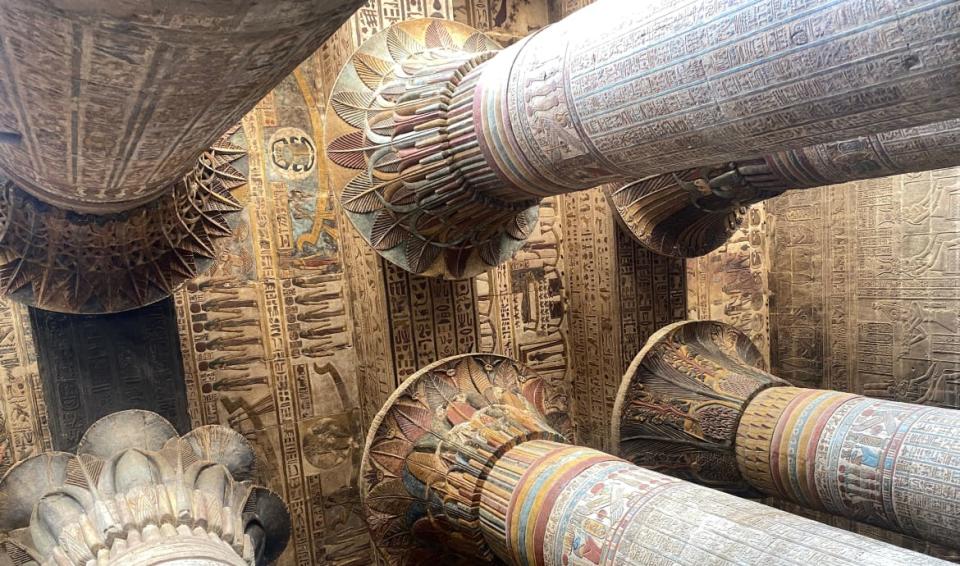
The intact colors of Esna Temple.
After the temple of Esna, you then board the boats which go upriver (south) in a combination of sailing and being towed. The first thing I noticed is that the Nile is actually a beautiful river. From above it looks placid like a lake but up close its dark waters are moving along at a steady clip. That first day you also learn that the food on board, while simple, is among the best you’ll have in Egypt.
The second day is spent visiting the tombs of El Kab, which seem a snooze compared to the grandeur of other sights, but their inscriptions are actually the source of a lot of our knowledge about the start of the New Kingdom. Afterwards you sail past the elegant domed stucco house of the Belgian archaeologist who documented the tombs. Whenever I would ask the locals why wealthy Egyptians don’t build villas along the Nile, they looked at me like I had three heads so I gave up. But seeing this house, I clearly wasn’t the only one who felt it would be idyllic!
After lunch it’s the soaring temple of Edfu and then your first Nile swim. Jumping into the water—something I’d wanted to do each day as temperatures soared—I was shocked by the bracing cold of the river. But you aren’t given time to dwell as the river starts moving you along pretty quickly. And while it’s definitely not clean enough to drink, the Nile was much cleaner than I was expecting it to be and I felt very comfortable swimming in it, crocodiles be damned.
The third day was the biggest surprise. My main fear going on the cruise was that five nights would be too long, and that I’d be bored out of my mind. I thought of it as a vehicle for doing stuff but on this day, where nothing is planned, I realized I just wanted to relax. I napped. I read. I wrote. And I turned a 45-minute lunch into a two-hour one because the very nature of these types of trips attract interesting people from around the world, creating an environment of scintillating conversations around day two or three.
On Thursday you visit a spot where most cruises cannot go, the quarry and tombs of Gebel Silsileh, where it’s easy to see the fascinating methods by which the Ancient Egyptians quarried their sandstone. Then it’s more swimming, and on the following day, Friday, the tour is capped by a visit to the Temple of Kom Ombo which has remarkably intact reliefs and is also notable for its extensive medical carvings. (Another anecdote stuck with me here. Apparently the Ancient Egyptians created the enema after watching the white egret. The bird was often constipated after eating loads of worms so it would pull water up its beak, bend over, insert its beak into its butt and spray.)
Nour el Nil’s journey ends in Aswan, a tidy Nubian city with a handful of islands dotting the Nile in the shadow of towering Saharan dunes. It’s an incredibly romantic town in the picturesque sense, and since most of the cruise ships end here midweek, by the weekend you’ll have the island temple of Philae and the colossal statues of Ramses II at Abu Simbel for you and just a few others.
For now, that is.
Get the Daily Beast's biggest scoops and scandals delivered right to your inbox. Sign up now.
Stay informed and gain unlimited access to the Daily Beast's unmatched reporting. Subscribe now.
